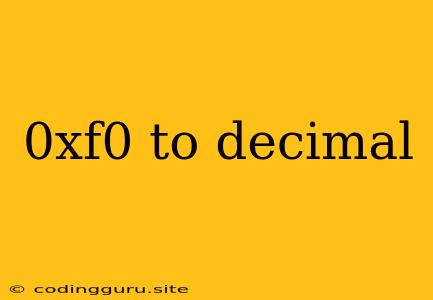Converting Hexadecimal to Decimal: Understanding 0xf0
In the world of programming and computing, numbers are often represented in various formats. One common format is hexadecimal, often denoted with a leading "0x". This format uses 16 unique symbols: 0-9 and A-F. Decimal, on the other hand, is the standard base-10 system we use in everyday life.
So, how do you convert a hexadecimal number like 0xf0 to its decimal equivalent? Let's break it down.
Understanding Hexadecimal and Decimal
- Hexadecimal (Base-16): Each digit in a hexadecimal number represents a power of 16. For example, the hexadecimal number 0xf0 is equivalent to (15 * 16^1) + (0 * 16^0).
- Decimal (Base-10): Each digit in a decimal number represents a power of 10. For example, the decimal number 245 is equivalent to (2 * 10^2) + (4 * 10^1) + (5 * 10^0).
Converting 0xf0 to Decimal
-
Break down the hex number: 0xf0 is made up of two digits: 'f' and '0'.
-
Convert each hex digit to decimal:
- 'f' in hexadecimal represents the decimal value 15.
- '0' in hexadecimal represents the decimal value 0.
-
Apply the place values:
- The 'f' is in the 16^1 (or 16) place.
- The '0' is in the 16^0 (or 1) place.
-
Calculate: (15 * 16^1) + (0 * 16^0) = 240.
Therefore, 0xf0 in hexadecimal is equivalent to 240 in decimal.
Tips for Converting Hex to Decimal
-
Memorize the first few hex digits: It can be helpful to remember the decimal equivalents of the common hex digits:
- 0x0 = 0
- 0x1 = 1
- 0x2 = 2
- ...
- 0x9 = 9
- 0xA = 10
- 0xB = 11
- 0xC = 12
- 0xD = 13
- 0xE = 14
- 0xF = 15
-
Use online calculators: Many online tools can convert hexadecimal numbers to decimal and vice versa.
Conclusion
Converting hexadecimal numbers to decimal is essential in various programming and computer-related tasks. By understanding the place values and how each digit represents a power of 16, you can easily convert any hexadecimal number to its decimal equivalent. Remember, the process involves converting each hex digit individually and then multiplying by the appropriate power of 16 before summing the results.
